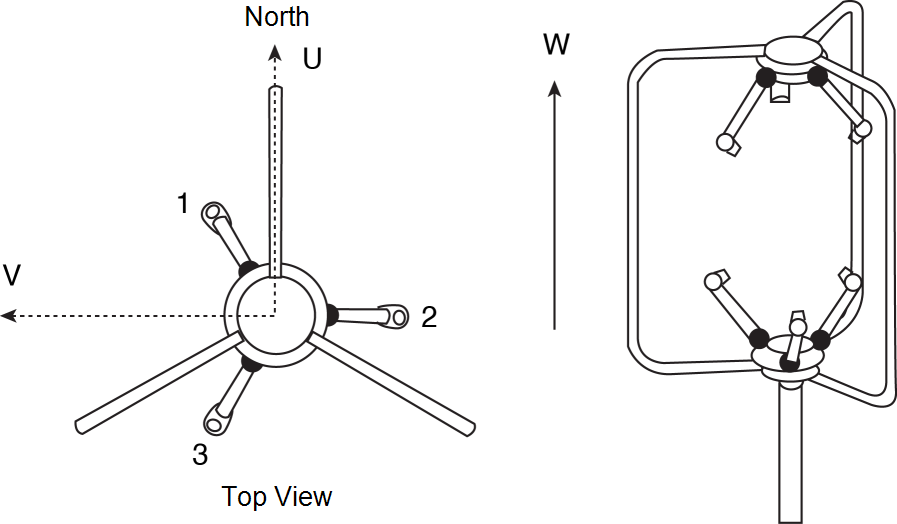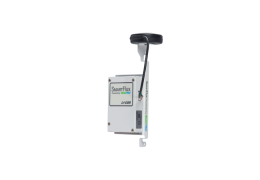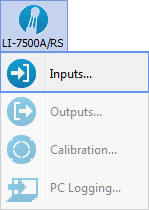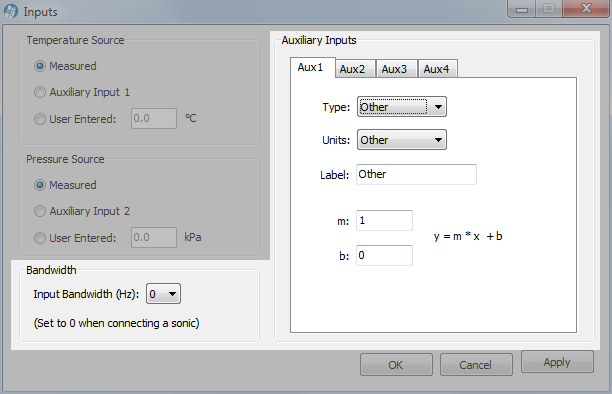Configuring the Analog Anemometer Inputs
When the anemometer is connected to the LI-7550 (using the analog signal), the Inputs dialog must be configured in order to scale data from the anemometer properly.
IMPORTANT: It is mandatory to specify the scaling of the wind speed measurements to allow EddyPro Software to read these values and calculate fluxes.
...or... 
- The four Auxiliary Inputs (Aux1...Aux4) correspond with U, V, W, and Ts (or SOS) output from the anemometer.
- Type specifies the variable.
- Units are the units that will be logged with the variable.
- Label is logged in the data and metadata. It identifies the variable.
- Slope and offset values relate the measured variable with the voltage.
- Choose the Type of Input.
- The Type field allows you to choose from:
- U – Horizontal wind speed (m/s) as measured toward the direction in line with the north spar (see diagram below)
- V – Horizontal wind speed (m/s) as measured toward the direction of 90° counterclockwise from the north spar
- W – Vertical wind speed (m/s) as measured up the mounting shaft
- Ts – Sonic temperature (°C)
- SOS – Speed of sound (m/s)

- Choose the appropriate Units.
- The units available are typical wind speed units. The software provides some controls over the units that are available with each variable:
-
Type Units Other Other, m/s, cm/s, volts, K, and C U m/s, cm/s, volts V m/s, cm/s, volts W m/s, cm/s, volts Ts K, C, volts SOS m/s, cm/s, volts - Enter the Label.
- The Label will appear in the file header in both the data and/or metadata files. The label cannot be changed for any of U, V, W, Ts, or SOS. The label can be entered only when ‘Other’ is selected.
Slope and Offset Examples
The units selected for each auxiliary input determine the units label recorded in the data file header, as well as the file header in the metadata file used with EddyPro. As such, it is important to convert the anemometer output from voltage to data using the multiplier and offset.
For example, if you have configured your sonic anemometer to output U, V, and W values in volts, but want the data file and metadata file to record these values in m/s, you will need to set the multiplier and offset values to rescale the data.
The following table gives the appropriate values for m (multiplier) and b (offset) to be used when converting raw voltages into units of m/s, using the default sonic anemometer output ranges of -30 to +30 m/s for U and V, -5 to +5 m/s for W, and ‑40 °C to 70 °C (and speed of sound 300 to 370 m/s).
| U, V -30 to +30 m/s |
W -5 to +5 m/s |
Ts -40 to 70°C |
SOS 300 to 370 m/s |
|||||
|---|---|---|---|---|---|---|---|---|
| Sonic output (V) | m | b | m | b | m | b | m | b |
| 0-5V | 12 | -30 | 2 | -5 | 22 | -40 | 14 | 300 |
| ±5V | 6 | 0 | 1 | 0 | 11 | 15 | 7 | 335 |
| ±2.5V | 12 | 0 | 2 | 0 | 22 | 15 | 14 | 335 |
Example 1: You have configured the Gill WindMaster to output raw voltages for auxiliary input U over the range of 0 to 5 V, and over a full scale wind speed of -30 to +30 m/s. You want to convert the raw voltages to wind speed and output the values in units of m/s. What is the wind speed when the sonic anemometer outputs a raw voltage value of 0.5 V?
- Set the Type field to U. Set the Units field to m/s. The Label is set automatically.
- Enter 12 for the Multiplier (m) and -30 for the Offset (b).
Using the slope intercept equation:
the wind speed is calculated as
B‑2y = 12(0.5) + (-30) = -24 m/s
Example 2: You have configured the Gill WindMaster to output raw voltages for auxiliary input U over the range of ±5V, and over a full scale wind speed of -30 to +30 m/s. You want to convert the raw voltages to wind speed and output the values in units of m/s. What is the wind speed when the sonic anemometer outputs a raw voltage value of 1.5V?
- Set the Type field to U. Set the Units field to m/s. The Label is set automatically.
- Enter 6 for the Multiplier (m) and 0 for the Offset (b).
Using equation B‑1, the wind speed is calculated as
B‑3y = 6(1.5) + 0 = 9 m/s


